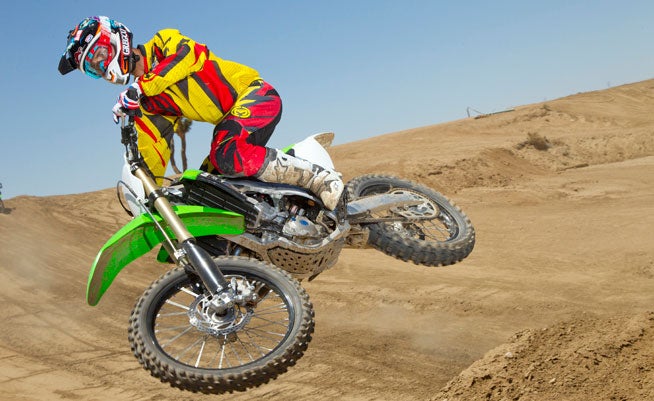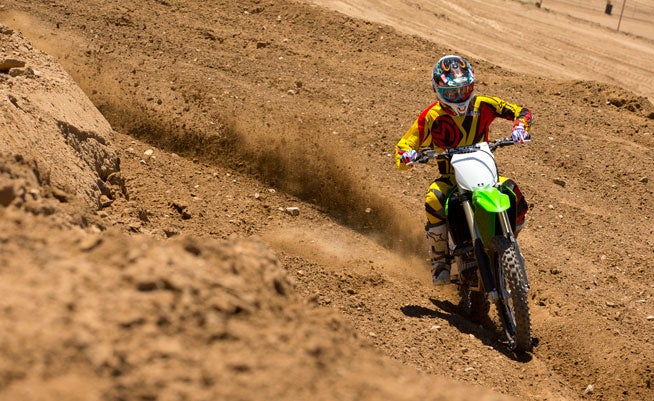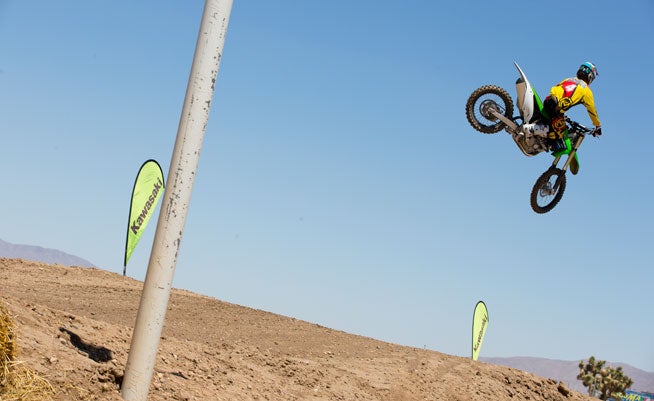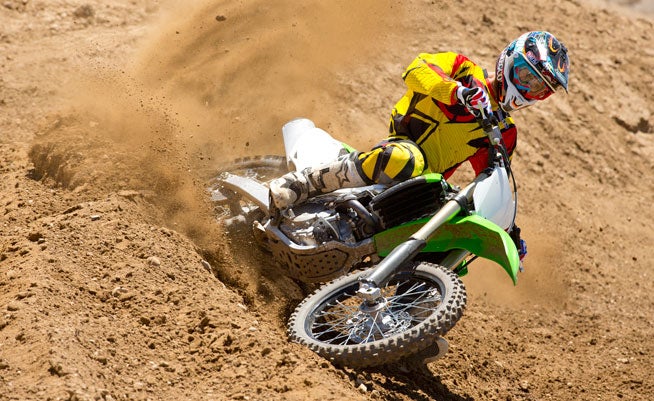
Kawasaki’s KX450F has fared well in magazine shootouts in the past few years, and its championship record in the hands of Ryan Villopoto is enviable, with three consecutive AMA Supercross titles to its credit. Villopoto is the current points leader in the 2013 AMA National Motocross Championship as well.
For 2014, Kawasaki saw no real reason to shake up the program with major changes to the KX450F, instead electing to focus more attention on the KX250F. The KX450F gets new graphics and a set of slimmer stock handgrips.
But can swapping to a pair of new grips make a difference? We were anxious to find out, as Kawasaki invited us to Competitive Edge Motocross Park in Hesperia, California, to shake down the 2014 KX450F and the KX250F. To give the bikes a thorough test, we enlisted the services of WORCS and SCORE Baja off-road racer Ryan Abbatoye. The epitome of a hired gun, Abbatoye was recently tapped by factory KTM rider Kendall Norman to race the Tecate SCORE Baja 500, and the pair carded a runner-up finish in the motorcycle class.
Abbatoye himself is a long-time KX450F owner, and the stock grips, are one of the first things he ditches on his personal bike, as he says their size and contour give him blisters during long, hard rides. But a day of testing with the new grips left his hands feeling fresh. That may not make the aftermarket grip manufacturers happy, although we doubt that their sales are in any jeopardy.

Engine Performance
Beyond that, all of the strengths that the KX450F enjoyed in 2013 return for 2014. For starters, the Kawasaki brings a hearty motor to the party. Its 449cc, liquid-cooled, DOHC, four-stroke single is designed to last, with a works-based bridged-box bottom piston designed to maintain rigidity, while its crankshaft is balanced to the specs of Villopoto’s factory KX450F in order to reduce vibration and provide ideal inertial mass for optimum rear wheel traction. Its compact cylinder head uses double valve springs to help ensure stable valve operation at high rpm, and its camshafts, lobes and tappet surfaces feature a soft-nitride treatment for long wear and high-rpm reliability. Its crankshaft and connecting rod also benefit special carburizing and quenching treatment to maximize rigidity, boosting long-term reliability without adding any weight.
Fuel is fed to the big KX by a 43mm Keihin throttle body with Digital Fuel Injection (DFI) that features an altra-fine atomizing injector with 12 holes that spray particles with a droplet size of 60μ for excellent fuel atomization, which contributes to the KX’s smooth power delivery and crisp throttle response. The system uses two linked shafts so that the throttle body opens more quickly after reaching the 3/8 open position.
Of course, you can’t mention the motor without discussing Kawasaki’s Launch Control system, which is designed to help the rider get good starts by maximizing available traction. Pushing the Launch Control button retards ignition timing in first and second gears, giving the greatest effect within the first few seconds of releasing the clutch. Shifting into third gear automatically deactivates Launch Control Mode and returns the ignition to normal mapping.
But what matters most is how the KX450F works on the track, and a full day of riding at Competitive Edge, Abbatoye says that it works extremely well. The 450 delivers a wealth of low-end punch right at the hit of the throttle, blasting cleanly out of corners with authority and making it easy to set up for obstacles with a short run-up, such as supercross-style triple jumps. Tractability in stock form is excellent, and the KX450’s swappable ignition coupler caps provide a good way to tailor the power to suit track conditions. In tacky, high-traction loam, might want to go with the Soft Terrain cap to unleash the full power of the KX450F to the rear wheel. Harder and/or slicker tracks can be managed by switching to the Hard Terrain cap, which will pull ignition timing to limit wheel spin. The Stock cap is designed to provide the best of all worlds, but the ECU is The ECU is also fully re-programmable and custom maps can be created using Kawasaki’s accessory Racing Software Calibration Kit.
The KX450F’s throttle response is spot-on, and that, too, makes the bike easier to ride. The motor maintains a silky, linear as the revs build. Even so, Abbatoye found that the KX450F is happiest at lower rpm. There’s no need to be aggressive with the throttle in order to set quick lap times, and that should make the KX450F appealing to vet riders and Open-class newbies alike. Make no mistake, the 450 packs a mighty wallop, but it doesn’t have to be intimidating. The KX450F’s close-ratio five-speed transmission also shifts smoothly, and its gear spacing with the stock gearing left nothing to complain about on the long and flowing Competitive Edge track.

Suspension
Kawasaki introduced the 48mm Kayaba Pneumatic Spring Fork (PSF) on its 2013 KX450F, and the fork returns for 2014. Instead of traditional coil springs, the PSF relies solely on pressurized air to act as the “spring.” While 32mm damping cartridges are used to increase bottoming resistance. Kawasaki claims that the design shaves 1.7 lbs. of weight from the front end and improves the fork’s ability to follow terrain contours thanks to reduced internal friction. It’s also supposed to be easier to tune using the supplied high-pressure hand pump, which is similar to a mountain bike shock pump. With no springs to grind against the inside of the fork tubes, PSD reduced oil contamination. The outer surfaces of the inner fork tubes wear a super-hard Diamond-Like Carbon (DLC) coating while a high-tech Kashima Coat treatment on the inner surface of the outer fork tubes is used to reduce drag for more supple action.
The PSF fork works well to tame everything from ripple bumps to G-outs at Competitive Edge, although its initial feel might take some getting used to. Abbatoye said that the fork exhibits more of a “dead” feeling than the more conventional coil spring forks that he is used to, although he had no issues with its performance, especially considering that it is intended strictly for motocross.
Yet we still have to wonder about their viability for off-road use, where a coil spring fork may still provide some durability and maintenance advantages over the PSF. Kawasaki PR spokesman and Team Green racing legend Destry Abbott claims that his team has been using the air fork with good success in off-road competition over the past year, although Abbott admits that the fork does pump up a little during a long off-road race. However, Abbott also says that the fork’s increased bottoming resistance in rocks is a real plus. Regardless, the PSF will still require the average rider to pay more attention to maintenance and adjustment to make sure that the pressure stays consistent from ride to ride.
The KX450F’s Kayaba shock matches the fork’s excellent performance on the motocross track. Motorcycle suspension has been moving toward larger pistons better low-speed sensitivity and good compression feel under braking, and the KX’s shock sports a beefy 50mm piston for that reason, along with a Kashima Coat surface treatment on the inside walls of the shock body to further reduce drag. It also offers plenty of tuning options, with 33-position rebound damping, 22-position high-speed compression damping and step-less low-speed damping adjustability.

Chassis
Abbatoye said he feels that the KX’s aluminum perimeter chassis may not exhibit the razor-precise cornering of Honda’s CRF450F and Suzuki’s RM-Z450, but the KX450F can still carve a tight line and will go wherever it is pointed with no major issues. On the other hand, its high-speed stability is never in doubt no matter how fast you’re going or how rough the terrain. Abbatoye reported that the cockpit feels extremely slim through the midsection for easy movement fore and aft by the rider, but it, too, is adjustable thanks to triple clamps that offer a choice of four different handlebar positions and footpegs that can set in two different positions. On top of that, Kawasaki offers an optional rear suspension tie rod that is one millimeter longer than stock, which can be used to reduce seat height by four millimeters.
One area where Abbatoye feels the Kawasaki also excels is under braking. Kawasaki introduced new brakes on the 2013 450F that were worlds better than the 2012 model, and the 2014 model gets the same petal-style 250mm front rotor and twin-piston caliper up front and 240mm petal-style rear rotor gripped by a single-piston rear caliper. The brakes offer a strong stopping power with a linear feel and just-right sensitivity.
Styling
Styling-wise, the KX450’s new graphics are augmented by an anodized blue finish on the oil cap and two caps on the generator cover to give the bike more of a “factory” appearance. These items match the blue anodized finish on the suspension adjusters, while a “K” logo on the clutch cover looks trick and is also designed to help hide signs of wear.
We’d like to thank Kawasaki for inviting us to sample the KX450F. It was a tough customer in the Open class last year, and 2014 appears to be no different, although time will tell whether other slightly revised models such as the CRF450R and the RM-Z450 will match the Kawasaki’s pace or if Yamaha’s new YZ450F comes in and steals their thunder. Looks like it’s open season all over again.
 Your Privacy Choices
Your Privacy Choices